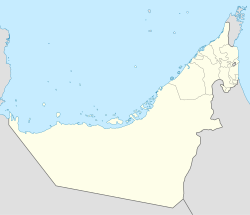Umm Al Nar
| |
|---|---|
| Coordinates: 24°26′18″N 54°30′52″E / 24.43833°N 54.51444°E | |
| Country | |
| Elevation | 5 m (16 ft) |
| This article is part of a series on the |
| History of the United Arab Emirates |
|---|
 |
|
|
Umm Al Nar (Arabic: أُمّ الـنَّـار, romanized: Umm an-Nār or Umm al-Nar, lit. 'Mother of the Fire') is a Bronze Age culture that existed around 2600-2000 BCE in the area of the modern-day United Arab Emirates and Northern Oman. The etymology derives from the island of the same name which lies adjacent to the city of Abu Dhabi, the capital of the UAE, which provided early evidence and finds that came to define the period.[1][2]
The Umm Al Nar people were important regional trading intermediaries between the ancient civilisations of Sumer in Mesopotamia and the Indus Valley Harappan culture. Known to the Sumerians as 'Magan', the area was the source of Sumer's copper and diorite as well as a trading entrepot for other goods from the Indus Valley, including carnelian jewellery.
- ^ UAE History: 20,000 - 2,000 years ago - UAEinteract Archived 2013-06-13 at the Wayback Machine
- ^ "UNESCO - Tentative Lists". Settlement and Cemetery of Umm an-Nar Island. UNESCO. Retrieved 18 December 2017.
